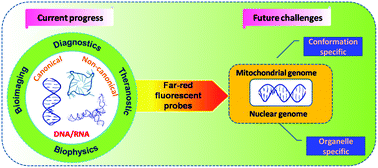当前位置:
X-MOL 学术
›
Chem. Soc. Rev.
›
论文详情
Our official English website, www.x-mol.net, welcomes your
feedback! (Note: you will need to create a separate account there.)
Far-red fluorescent probes for canonical and non-canonical nucleic acid structures: current progress and future implications
Chemical Society Reviews ( IF 40.4 ) Pub Date : 2017-12-21 00:00:00 , DOI: 10.1039/c7cs00774d Y. V. Suseela 1, 2, 3, 4, 5 , Nagarjun Narayanaswamy 1, 2, 3, 4, 5 , Sumon Pratihar 1, 2, 3, 4, 5 , Thimmaiah Govindaraju 1, 2, 3, 4, 5
Chemical Society Reviews ( IF 40.4 ) Pub Date : 2017-12-21 00:00:00 , DOI: 10.1039/c7cs00774d Y. V. Suseela 1, 2, 3, 4, 5 , Nagarjun Narayanaswamy 1, 2, 3, 4, 5 , Sumon Pratihar 1, 2, 3, 4, 5 , Thimmaiah Govindaraju 1, 2, 3, 4, 5
Affiliation

|
The structural diversity and functional relevance of nucleic acids (NAs), mainly deoxyribonucleic acid (DNA) and ribonucleic acid (RNA), are indispensable for almost all living organisms, with minute aberrations in their structure and function becoming causative factors in numerous human diseases. The standard structures of NAs, termed canonical structures, are supported by Watson–Crick hydrogen bonding. Under special physiological conditions, NAs adopt distinct spatial organisations, giving rise to non-canonical conformations supported by hydrogen bonding other than the Watson–Crick type; such non-canonical structures have a definite function in controlling gene expression and are considered as novel diagnostic and therapeutic targets. Development of molecular probes for these canonical and non-canonical DNA/RNA structures has been an active field of research. Among the numerous probes studied, probes with turn-on fluorescence in the far-red (600–750 nm) region are highly sought-after due to minimal autofluorescence and cellular damage. Far-red fluorescent probes are vital for real-time imaging of NAs in live cells as they provide good resolution and minimal perturbation of the cell under investigation. In this review, we present recent advances in the area of far-red fluorescent probes of DNA/RNA and non-canonical G-quadruplex structures. For the sake of continuity and completeness, we provide a brief overview of visible fluorescent probes. Utmost importance is given to design criteria, characteristic properties and biological applications, including in cellulo imaging, apart from critical discussion on limitations of the far-red fluorescent probes. Finally, we offer current and future prospects in targeting canonical and non-canonical NAs specific to cellular organelles, through sequence- and conformation-specific far-red fluorescent probes. We also cover their implications in chemical and molecular biology, with particular focus on decoding various disease mechanisms involving NAs.
中文翻译:

用于规范和非规范核酸结构的远红荧光探针:当前进展和未来意义
核酸(NA)(主要是脱氧核糖核酸(DNA)和核糖核酸(RNA))的结构多样性和功能相关性对于几乎所有活生物体都是必不可少的,其结构和功能的微小异常成为许多人类疾病的致病因素。沃森-克里克氢键支持NA的标准结构,称为规范结构。在特殊的生理条件下,NAs具有截然不同的空间组织,从而产生了由Watson-Crick类型以外的氢键支持的非规范构象。这样的非规范结构在控制基因表达中具有确定的功能,并且被认为是新颖的诊断和治疗靶标。用于这些规范和非规范DNA / RNA结构的分子探针的开发一直是一个活跃的研究领域。在众多研究的探针中,由于极少的自发荧光和细胞损伤,在远红色(600–750 nm)区域具有开启荧光的探针受到高度追捧。远红外荧光探针对于活细胞中NA的实时成像至关重要,因为它们提供了良好的分辨率,并且对所研究细胞的干扰最小。在这篇综述中,我们介绍了DNA / RNA的远红色荧光探针和非规范G-四链体结构领域的最新进展。为了连续性和完整性,我们提供可见荧光探针的简要概述。最重要的是设计标准,特征和生物学应用,包括 在众多研究的探针中,由于极少的自发荧光和细胞损伤,在远红色(600–750 nm)区域具有开启荧光的探针受到高度追捧。远红外荧光探针对于活细胞中NA的实时成像至关重要,因为它们提供了良好的分辨率,并且对所研究细胞的干扰最小。在这篇综述中,我们介绍了DNA / RNA的远红色荧光探针和非规范G-四链体结构领域的最新进展。为了连续性和完整性,我们提供可见荧光探针的简要概述。最重要的是设计标准,特征和生物学应用,包括 在众多研究的探针中,由于极少的自发荧光和细胞损伤,在远红色(600–750 nm)区域具有开启荧光的探针受到高度追捧。远红外荧光探针对于活细胞中NA的实时成像至关重要,因为它们提供了良好的分辨率,并且对所研究细胞的干扰最小。在这篇综述中,我们介绍了DNA / RNA的远红色荧光探针和非规范G-四链体结构领域的最新进展。为了连续性和完整性,我们提供可见荧光探针的简要概述。最重要的是设计标准,特征和生物学应用,包括 由于自发荧光和细胞损伤极小,因此在远红色(600–750 nm)区域具有开启荧光的探针非常受欢迎。远红外荧光探针对于活细胞中NA的实时成像至关重要,因为它们提供了良好的分辨率,并且对所研究细胞的干扰最小。在这篇综述中,我们介绍了DNA / RNA的远红色荧光探针和非规范G-四链体结构领域的最新进展。为了连续性和完整性,我们提供可见荧光探针的简要概述。最重要的是设计标准,特征和生物学应用,包括 由于自发荧光和细胞损伤极小,因此在远红色(600–750 nm)区域具有开启荧光的探针非常受欢迎。远红外荧光探针对于活细胞中NA的实时成像至关重要,因为它们提供了良好的分辨率,并且对所研究细胞的干扰最小。在这篇综述中,我们介绍了DNA / RNA的远红色荧光探针和非规范G-四链体结构领域的最新进展。为了连续性和完整性,我们提供可见荧光探针的简要概述。最重要的是设计标准,特征和生物学应用,包括 在这篇综述中,我们介绍了DNA / RNA的远红色荧光探针和非规范G-四链体结构领域的最新进展。为了连续性和完整性,我们提供可见荧光探针的简要概述。最重要的是设计标准,特征和生物学应用,包括 在这篇综述中,我们介绍了DNA / RNA的远红色荧光探针和非规范G-四链体结构领域的最新进展。为了连续性和完整性,我们提供可见荧光探针的简要概述。最重要的是设计标准,特征和生物学应用,包括除了关于远红色荧光探针的局限性的重要讨论外,在纤维素成像中的应用。最后,我们提供了通过序列和构象特异性的远红外荧光探针靶向针对细胞器的规范和非规范NA的当前和未来前景。我们还将介绍它们在化学和分子生物学中的意义,尤其着重于解码涉及NA的各种疾病机制。
更新日期:2017-12-21
中文翻译:

用于规范和非规范核酸结构的远红荧光探针:当前进展和未来意义
核酸(NA)(主要是脱氧核糖核酸(DNA)和核糖核酸(RNA))的结构多样性和功能相关性对于几乎所有活生物体都是必不可少的,其结构和功能的微小异常成为许多人类疾病的致病因素。沃森-克里克氢键支持NA的标准结构,称为规范结构。在特殊的生理条件下,NAs具有截然不同的空间组织,从而产生了由Watson-Crick类型以外的氢键支持的非规范构象。这样的非规范结构在控制基因表达中具有确定的功能,并且被认为是新颖的诊断和治疗靶标。用于这些规范和非规范DNA / RNA结构的分子探针的开发一直是一个活跃的研究领域。在众多研究的探针中,由于极少的自发荧光和细胞损伤,在远红色(600–750 nm)区域具有开启荧光的探针受到高度追捧。远红外荧光探针对于活细胞中NA的实时成像至关重要,因为它们提供了良好的分辨率,并且对所研究细胞的干扰最小。在这篇综述中,我们介绍了DNA / RNA的远红色荧光探针和非规范G-四链体结构领域的最新进展。为了连续性和完整性,我们提供可见荧光探针的简要概述。最重要的是设计标准,特征和生物学应用,包括 在众多研究的探针中,由于极少的自发荧光和细胞损伤,在远红色(600–750 nm)区域具有开启荧光的探针受到高度追捧。远红外荧光探针对于活细胞中NA的实时成像至关重要,因为它们提供了良好的分辨率,并且对所研究细胞的干扰最小。在这篇综述中,我们介绍了DNA / RNA的远红色荧光探针和非规范G-四链体结构领域的最新进展。为了连续性和完整性,我们提供可见荧光探针的简要概述。最重要的是设计标准,特征和生物学应用,包括 在众多研究的探针中,由于极少的自发荧光和细胞损伤,在远红色(600–750 nm)区域具有开启荧光的探针受到高度追捧。远红外荧光探针对于活细胞中NA的实时成像至关重要,因为它们提供了良好的分辨率,并且对所研究细胞的干扰最小。在这篇综述中,我们介绍了DNA / RNA的远红色荧光探针和非规范G-四链体结构领域的最新进展。为了连续性和完整性,我们提供可见荧光探针的简要概述。最重要的是设计标准,特征和生物学应用,包括 由于自发荧光和细胞损伤极小,因此在远红色(600–750 nm)区域具有开启荧光的探针非常受欢迎。远红外荧光探针对于活细胞中NA的实时成像至关重要,因为它们提供了良好的分辨率,并且对所研究细胞的干扰最小。在这篇综述中,我们介绍了DNA / RNA的远红色荧光探针和非规范G-四链体结构领域的最新进展。为了连续性和完整性,我们提供可见荧光探针的简要概述。最重要的是设计标准,特征和生物学应用,包括 由于自发荧光和细胞损伤极小,因此在远红色(600–750 nm)区域具有开启荧光的探针非常受欢迎。远红外荧光探针对于活细胞中NA的实时成像至关重要,因为它们提供了良好的分辨率,并且对所研究细胞的干扰最小。在这篇综述中,我们介绍了DNA / RNA的远红色荧光探针和非规范G-四链体结构领域的最新进展。为了连续性和完整性,我们提供可见荧光探针的简要概述。最重要的是设计标准,特征和生物学应用,包括 在这篇综述中,我们介绍了DNA / RNA的远红色荧光探针和非规范G-四链体结构领域的最新进展。为了连续性和完整性,我们提供可见荧光探针的简要概述。最重要的是设计标准,特征和生物学应用,包括 在这篇综述中,我们介绍了DNA / RNA的远红色荧光探针和非规范G-四链体结构领域的最新进展。为了连续性和完整性,我们提供可见荧光探针的简要概述。最重要的是设计标准,特征和生物学应用,包括除了关于远红色荧光探针的局限性的重要讨论外,在纤维素成像中的应用。最后,我们提供了通过序列和构象特异性的远红外荧光探针靶向针对细胞器的规范和非规范NA的当前和未来前景。我们还将介绍它们在化学和分子生物学中的意义,尤其着重于解码涉及NA的各种疾病机制。











































 京公网安备 11010802027423号
京公网安备 11010802027423号